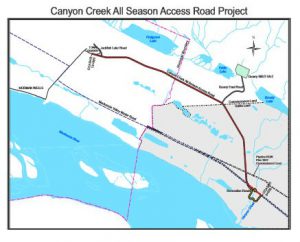The Government of the Northwest Territories and the federal government will be investing $20 million for the construction of a 14-kilometer all-season access road connecting Norman Wells to Canyon Creek.
The announcement came Thursday, and includes the construction of the all-seasons road, along with an additional five kilometers of roads around Canyon Creek.
The improved infrastructure means essential goods and equipment will be transported more easily throughout the area, and will “improve access to traditional Sahtu lands for recreation, tourism, and business development,” according to a GNWT press release.
The all-season road will replace the segment of the Mackenzie Valley Highway that’s constructed annually between the two communities.
The territorial government is providing $5 million in funding towards the $20 million project, with the remaining $15 million coming from the federal government through the Small Communities Fund.
“It’s a great investment,” said Wally Schumann, the territory’s transportation minister.
“$20 million going into the region where oil and gas has essentially come to a dead-stop, it means there’s some investment there and this is a great opportunity for a region that’s remote and a significant contribution to the economy in the next few years.”
The GNWT says other local communities are also expected to benefit from Thursday’s announcement.
“Residents, businesses and contractors in Tulita and Norman Wells will particularly benefit from the related business and employment opportunities [that come with the road],” read a press release.
“In addition, through training, this project will increase the capacity of local people and businesses to service future construction projects.”
The GNWT says the project will offer training opportunities to around 12 trainees and 16 heavy equipment operators, and provide work for up to 50 people during the construction phase.
Most of that staff is expected to be hired locally.





